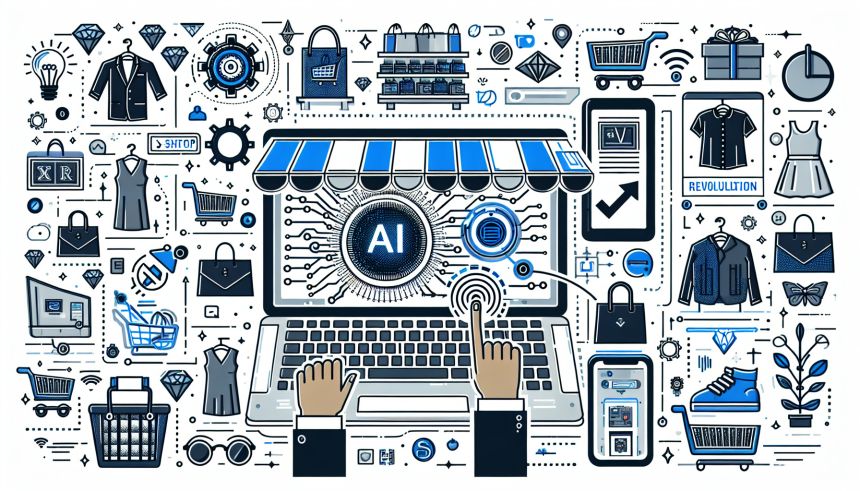Revolutionizing E-commerce: AI Tools That Personalize Shopping Experiences
Understanding AI in E-commerce
Artificial Intelligence (AI) has emerged as a transformative force in e-commerce, affecting various aspects of the shopping experience. Personalization is at the forefront of this transformation, enabling retailers to provide tailored experiences to their customers. With AI tools, businesses can analyze vast amounts of data to recognize patterns, preferences, and behaviors that inform more relevant shopping experiences.
Why Personalization Matters
Personalization in e-commerce enhances customer satisfaction, increases engagement, and drives sales. By presenting tailored product recommendations and content, businesses can create an experience that feels unique to each shopper. Research indicates that 80% of consumers are more likely to purchase from brands that offer personalized experiences, highlighting the importance of implementing personalization strategies.
AI-Powered Recommendation Engines
One of the most significant applications of AI in e-commerce is the recommendation engine. These systems utilize machine learning algorithms to suggest products based on past purchases, browsing history, and consumer preferences. For example, platforms like Amazon employ complex algorithms that analyze user behavior to recommend items, significantly boosting their conversion rates.
Key Features:
- Collaborative Filtering: This technique suggests products by finding similarities between users’ preferences. If User A and User B bought similar products, User A will see products favored by User B.
- Content-Based Filtering: This method relies on the attributes of the products themselves. If a customer frequently buys athletic shoes, the system will recommend similar brands or styles.
- Hybrid Approaches: Combining both collaborative and content-based methods offers a more robust recommendation system, enhancing user satisfaction and engagement.
Chatbots and Virtual Assistants
AI-driven chatbots and virtual assistants are revolutionizing customer service in e-commerce. These tools offer real-time support, answering queries, guiding users through the purchasing process, and providing personalized suggestions based on previous interactions.
Benefits of AI Chatbots:
- 24/7 Availability: Customers can receive support anytime, eliminating the frustrations of waiting in queues during traditional business hours.
- Personalization: By utilizing previous conversational data, chatbots can personalize responses, making customers feel understood and valued.
- Cost-Effectiveness: Businesses can reduce operational costs by employing chatbots for routine inquiries, allowing human employees to focus on complex issues.
Dynamic Pricing Strategies
AI technologies enable dynamic pricing strategies that adjust product prices based on demand, competition, user profiles, and market trends. Retailers leveraging these tools can optimize pricing in real-time, which helps maximize revenue while remaining competitive.
How It Works:
- Data Analysis: AI collects and analyzes data on various factors like competitor pricing, supply chain logistics, and consumer behavior.
- Algorithmic Adjustments: Prices can be adjusted automatically based on the insights gathered, ensuring prices are competitive yet profitable.
- Personalized Discounts: Targeted promotions can be offered to specific user segments based on browsing history, encouraging conversions and increasing customer loyalty.
Enhanced Search Functionality
AI-enhanced search capabilities can significantly improve the shopping experience. Traditional keyword-based searches can often yield irrelevant results, while AI can understand user intent and context, delivering more accurate results.
Features of AI Search:
- Natural Language Processing (NLP): This technology allows users to input queries in everyday language. AI interprets these queries to provide more relevant search results.
- Visual Search: Customers can upload images to find similar products online, tapping into AI’s image recognition capabilities to further engage shoppers.
- Semantic Search Engines: These engines understand relational meanings and connections between words, improving the relevancy of search outcomes.
Customer Segmentation and Targeting
AI tools can analyze customer data to create detailed customer segments based on demographics, purchase behaviors, and preferences. This segmentation allows for highly targeted marketing messages, increasing the likelihood of conversion.
Strategic Implementation:
- Behavioral Segmentation: Categorizing users based on their interactions with the brand enables businesses to tailor their marketing strategies effectively.
- Predictive Analytics: AI can predict future buying behavior based on past actions, leading to more effective targeting strategies and customer engagement.
- Retargeting Campaigns: AI facilitates personalized retargeting by showing specific products that potential customers viewed but did not purchase, thereby rekindling interest.
Augmented Reality (AR) and Virtual Reality (VR)
Incorporating AI with AR and VR technologies offers immersive shopping experiences that can transform how customers interact with products. These tools allow consumers to visualize products in their environment before making a purchase.
Applications in E-commerce:
- Virtual Try-Ons: Fashion retailers use AR to enable customers to try on clothing or makeup virtually, enhancing the confidence in their purchase decisions.
- Interactive Product Demos: VR allows customers to experience products in a simulated environment, making e-commerce more engaging and informative.
- Real-Time Feedback: AI can analyze user interactions with AR/VR elements to refine offerings continually and improve customer experience.
Demand Forecasting
AI plays a pivotal role in demand forecasting, enabling businesses to make informed inventory decisions. This capability minimizes instances of overstocking or stockouts, thus optimizing supply chain efficiency.
Forecasting Techniques:
- Machine Learning Algorithms: These algorithms analyze historical sales data, market trends, and external factors, predicting future demand accurately.
- Enhanced Supply Chain Management: AI-driven insights allow for better planning and logistics, ensuring that retailers can meet customer expectations without excessive inventory costs.
- Seasonal Trends Identification: Businesses can utilize AI to identify patterns related to seasons, holidays, or events that influence purchasing behavior.
Conclusion
AI is creating an exciting new frontier for e-commerce, providing tools that enable businesses to offer highly personalized shopping experiences. From recommendation engines that understand consumer preferences to chatbots providing real-time support, the innovation driven by AI is set to redefine how consumers engage with online retail. By adopting these technologies, e-commerce businesses not only enhance the customer experience but also secure a competitive edge in an increasingly crowded marketplace. The future of personalized shopping is here, and it’s powered by AI.


